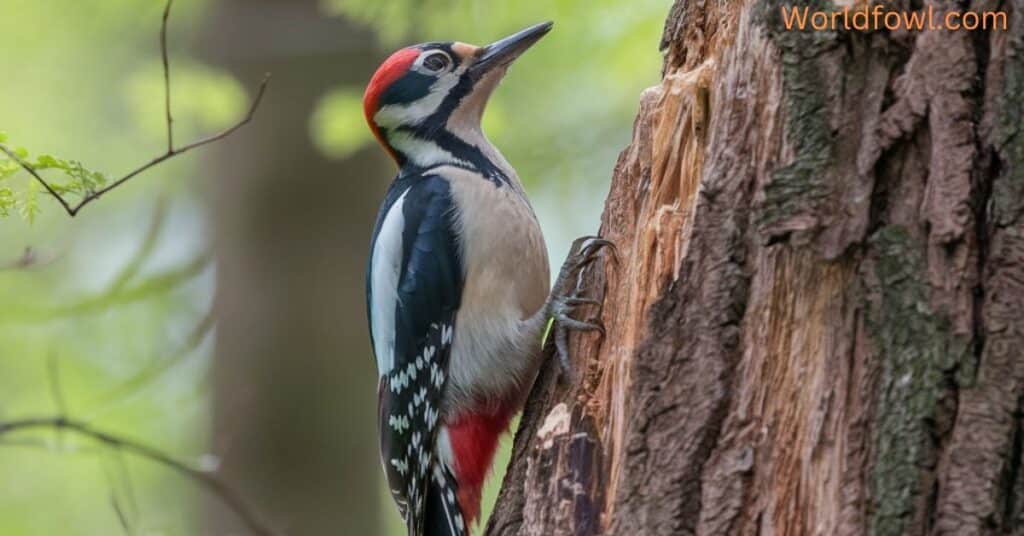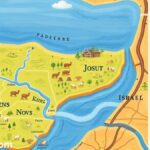British Columbia’s diverse landscapes, from coastal rainforests to interior dry pinelands, resonate with the rhythmic drumming of woodpeckers. These remarkable birds play a crucial role in the province’s ecosystems, and their presence is a testament to the health of our forests. In this extensive guide, we’ll explore the 11 species of woodpeckers in British Columbia, delving into their unique characteristics, behaviors, and the challenges they face.
Introduction: The Rhythmic World of Woodpeckers in British Columbia
Woodpeckers in British Columbia are nature’s percussionists, their rapid-fire drumming echoing through the province’s varied landscapes. These feathered architects are more than just noisemakers; they’re vital players in the forest ecosystem. From controlling insect populations to creating homes for other wildlife, woodpeckers in British Columbia are true ecosystem engineers.
Quick Facts About Woodpecker Adaptations
- Shock-absorbing skull: Woodpeckers have evolved a spongy bone in their skull that acts as a shock absorber, preventing brain damage from their powerful drumming.
- Sticky tongues: Many woodpeckers have tongues that can extend up to 4 inches beyond their beaks, perfect for snagging insects deep in tree crevices.
- Zygodactyl feet: Their unique foot structure, with two toes pointing forward and two backward, allows for excellent grip on vertical surfaces.
- Stiff tail feathers: These act as a prop, supporting the woodpecker as it clings to tree trunks.
you may also like : Where Do Hummingbirds Go At Night? Hummingbird Night Life Exposed
Meet the Drummers: 11 Woodpeckers Calling British Columbia Home
American Three-toed Woodpecker
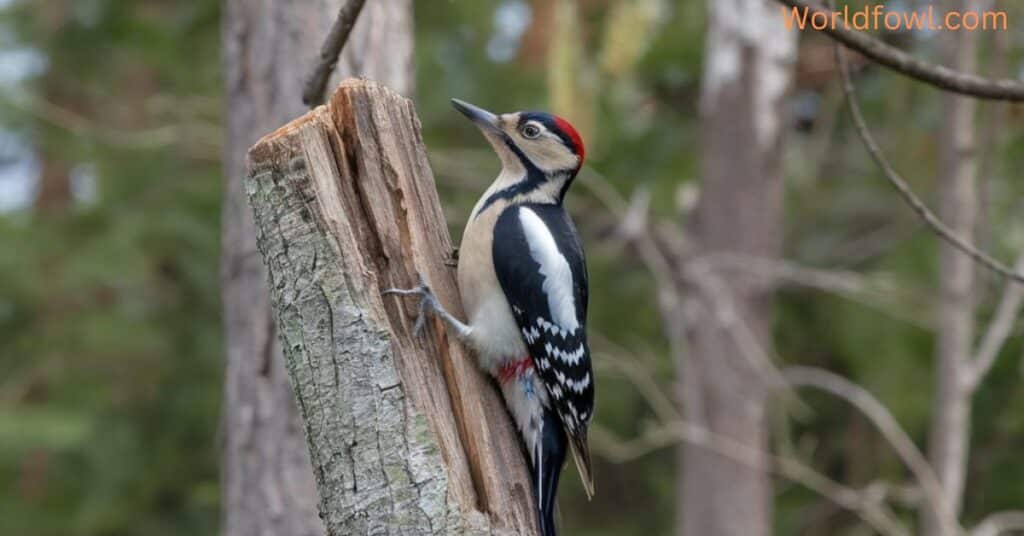
The American Three-toed Woodpecker is a boreal specialist, thriving in British Columbia’s northern and high-elevation forests. This medium-sized woodpecker is a master of bark-scaling, a technique used to expose bark beetles, their primary food source.
Unique features and behavior:
- Distinctive yellow cap on males
- Only three toes on each foot (most woodpeckers have four)
- Quiet and methodical foraging style
Habitat preferences in British Columbia:
- Mature coniferous forests, especially spruce and fir
- Recently burned areas or those affected by beetle infestations
Conservation status:
- Least Concern globally, but populations can fluctuate with insect outbreaks
Black-backed Woodpecker
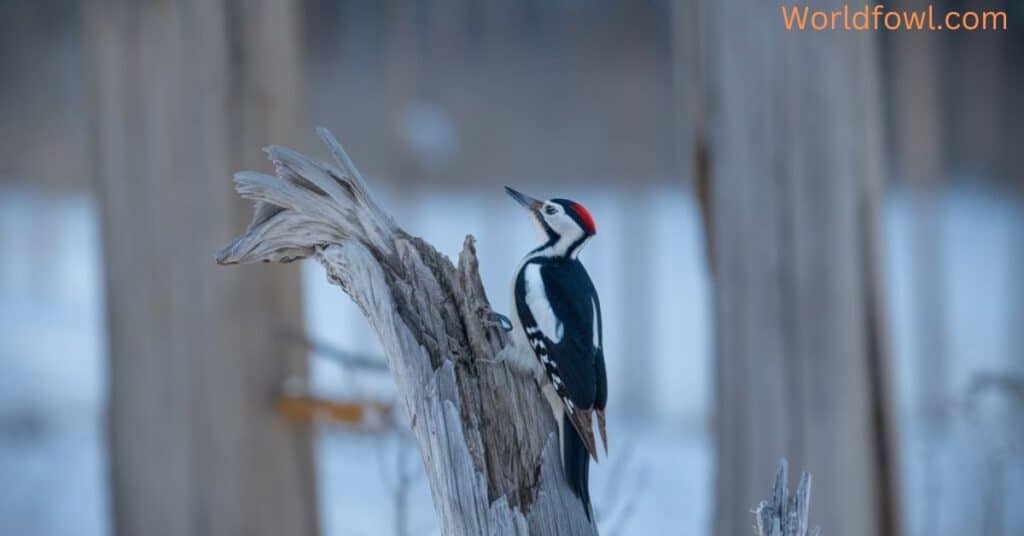
The Black-backed Woodpecker is a fire specialist, often being the first bird species to colonize recently burned forests in British Columbia. Their jet-black plumage provides perfect camouflage against charred tree trunks.
Distinctive markings and adaptations:
- Solid black back (unique among North American woodpeckers)
- White stripe down the side of the head
- Exceptionally strong bill for excavating deep into wood
Role in post-fire forests:
- Key predator of wood-boring beetle larvae in burned trees
- Creates nesting cavities used by other species in recovering forests
Spotting tips for British Columbia birders:
- Look for them in areas affected by recent wildfires
- Listen for their distinctive sharp “pik” call
Downy Woodpecker
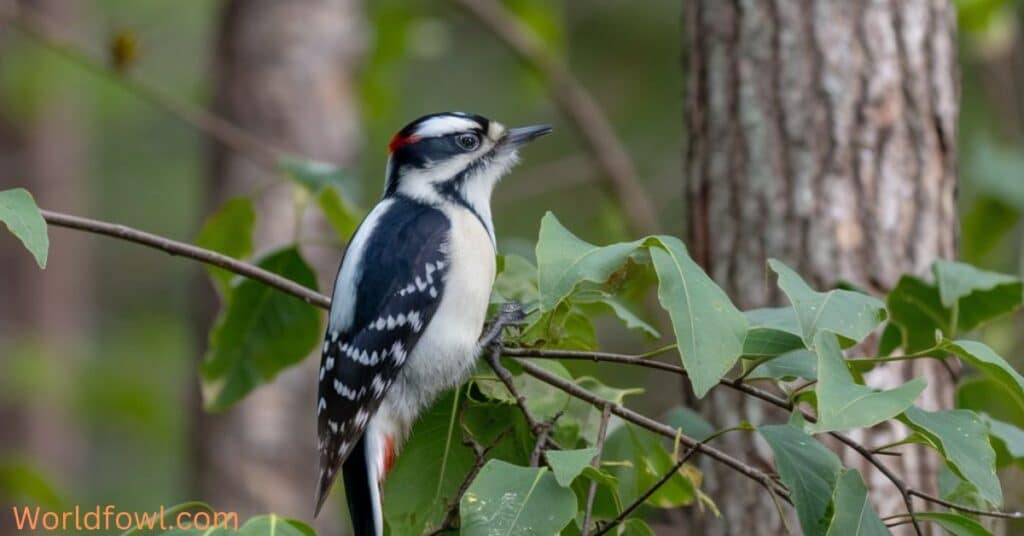
The Downy Woodpecker is British Columbia’s smallest woodpecker and a common backyard visitor. These adaptable birds are equally at home in forests and urban parks throughout the province.
Size and appearance:
- Length: 14-17 cm
- Weight: 21-28 grams
- Black and white plumage with a small red patch on males’ napes
Common backyard visitor:
- Frequently seen at suet feeders in British Columbia gardens
- Often found in mixed-species foraging flocks in winter
Feeding habits and preferences:
- Insects, especially wood-boring beetle larvae
- Seeds and berries, particularly in winter
- Sap from sapsucker wells
you may like : Can Seagulls Breathe Underwater? How Do Seagulls Avoid Drowning?
Hairy Woodpecker
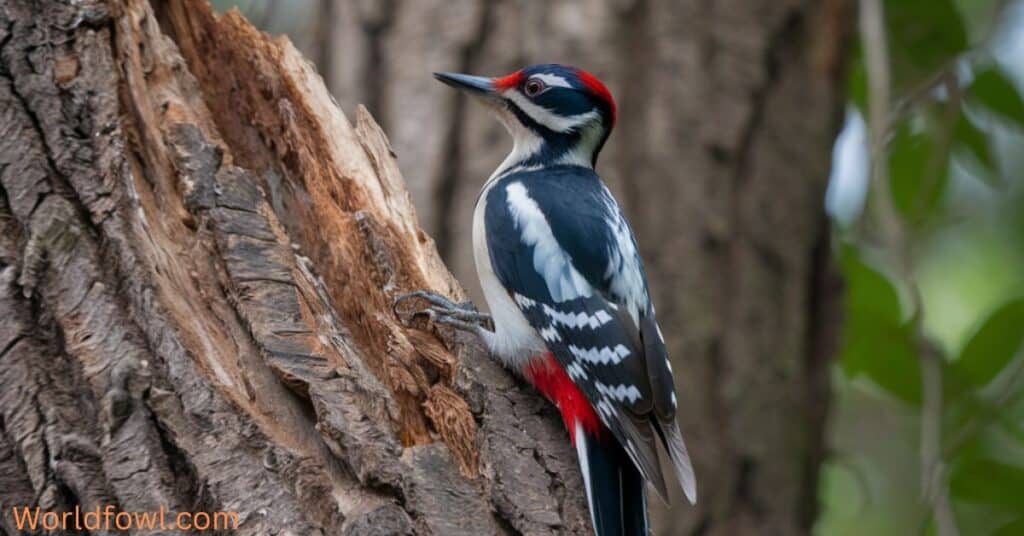
Often confused with its smaller cousin, the Downy Woodpecker, the Hairy Woodpecker is a larger, more robust bird with a longer bill. This species is found throughout British Columbia’s forested areas.
Differentiating from Downy Woodpeckers:
- Larger size (23-26 cm long)
- Bill nearly as long as the head (Downy’s bill is about 1/3 the length of the head)
- Lacks black spots on white outer tail feathers
Habitat range in British Columbia:
- Found throughout the province in mature forests
- Adapts well to suburban areas with large trees
Nesting behaviors:
- Excavates new nest cavities each year
- Nest holes typically 8-12 meters high in dead trees
Lewis’s Woodpecker
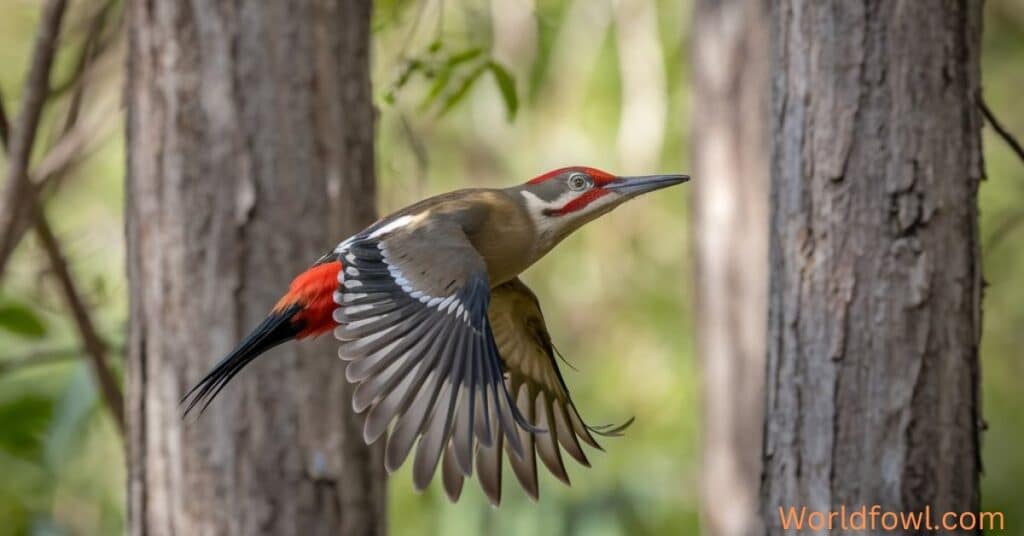
Named after Meriwether Lewis of the Lewis and Clark expedition, this woodpecker is a unique and threatened species in British Columbia.
Unique coloration and flight patterns:
- Greenish-black back with pinkish belly
- Red face patch
- Crow-like flight with slow, deep wing beats
British Columbia’s at-risk woodpecker:
- Blue-listed (vulnerable) in British Columbia
- Declining due to habitat loss and competition with European Starlings
Conservation efforts in the province:
- Habitat restoration in the Okanagan and East Kootenay regions
- Nest box programs to provide alternative nesting sites
Northern Flicker
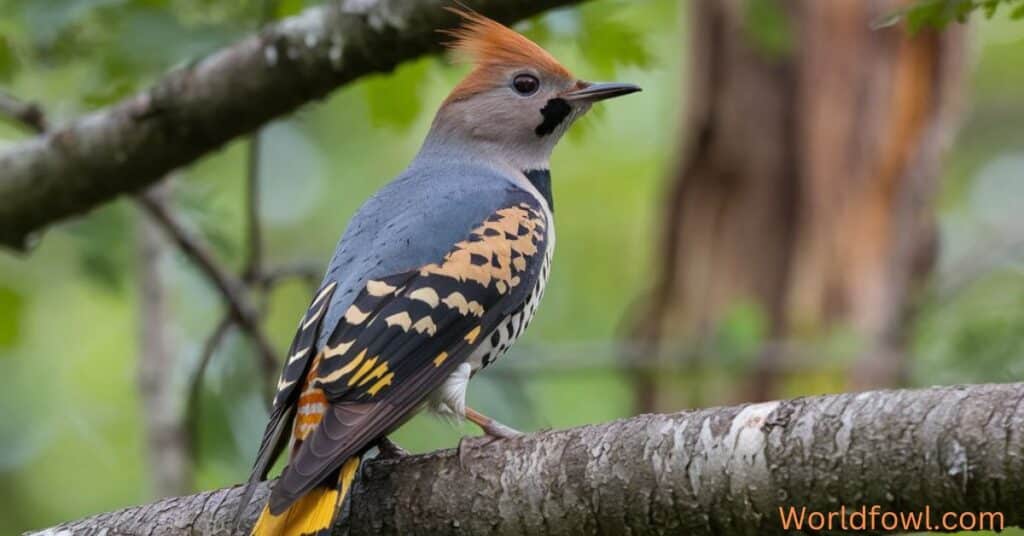
The Northern Flicker is British Columbia’s ground-feeding woodpecker, often seen probing lawns for ants and beetles throughout the province.
Ground-feeding habits:
- Spends more time on the ground than other woodpeckers
- Powerful bill used to dig for ants and beetle larvae
Red-shafted vs. Yellow-shafted in British Columbia:
- British Columbia primarily hosts the Red-shafted subspecies
- Hybridization occurs in eastern parts of the province
Importance in British Columbia’s urban ecosystems:
- Crucial role in controlling ant populations
- Cavity nests provide homes for many secondary cavity-nesters
you may like : Do Robins Mate For Life? The Complete Guide To Robin Romance
Pileated Woodpecker
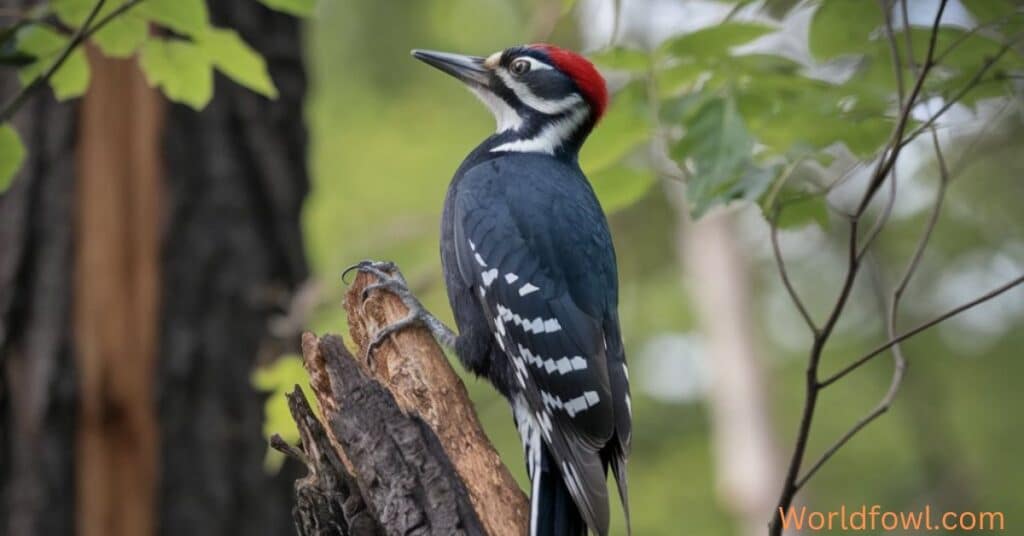
The Pileated Woodpecker is British Columbia’s largest woodpecker and a keystone species in forest ecosystems throughout the province.
British Columbia’s largest woodpecker:
- Length: 40-49 cm
- Wingspan: 66-75 cm
- Distinctive red crest and black body
Impact on forest ecosystems:
- Creates large cavities used by many other species in British Columbia forests
- Helps control populations of carpenter ants and wood-boring beetles
Identifying their distinctive work:
- Large, rectangular excavations in trees
- Piles of fresh wood chips at the base of worked trees
Red-breasted Sapsucker
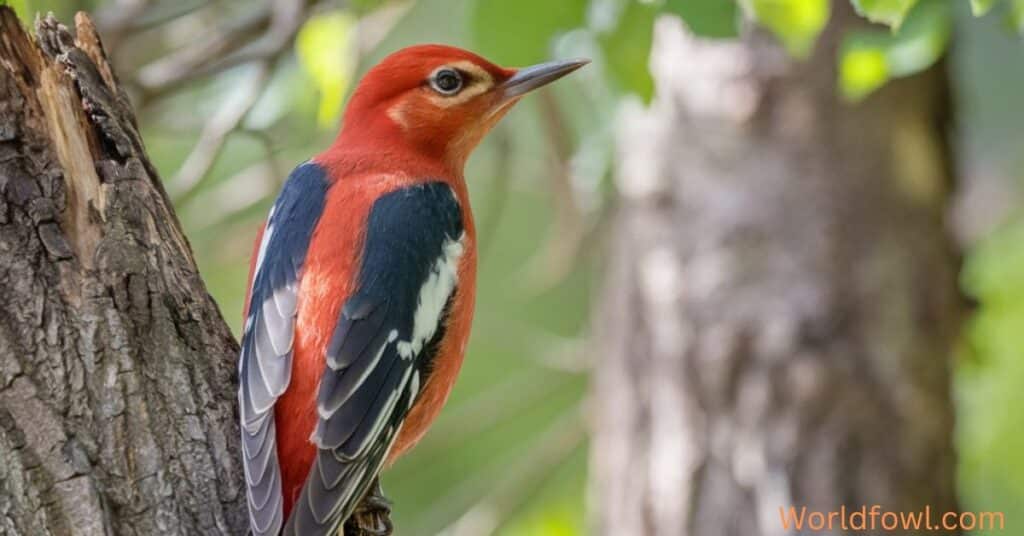
The Red-breasted Sapsucker is a striking bird known for its unique feeding habits and its importance to other species in British Columbia’s coastal forests.
Sap-feeding techniques:
- Drills neat rows of holes in tree bark
- Revisits these “sap wells” regularly to feed on sap and trapped insects
Relationship with hummingbirds:
- Rufous Hummingbirds often follow sapsuckers to feed from their sap wells
- This relationship may influence hummingbird migration timing in British Columbia
Range and habitat in British Columbia:
- Coastal forests from Vancouver Island to the Alaska border
- Prefers deciduous or mixed forests, especially those with alder and maple
Red-naped Sapsucker
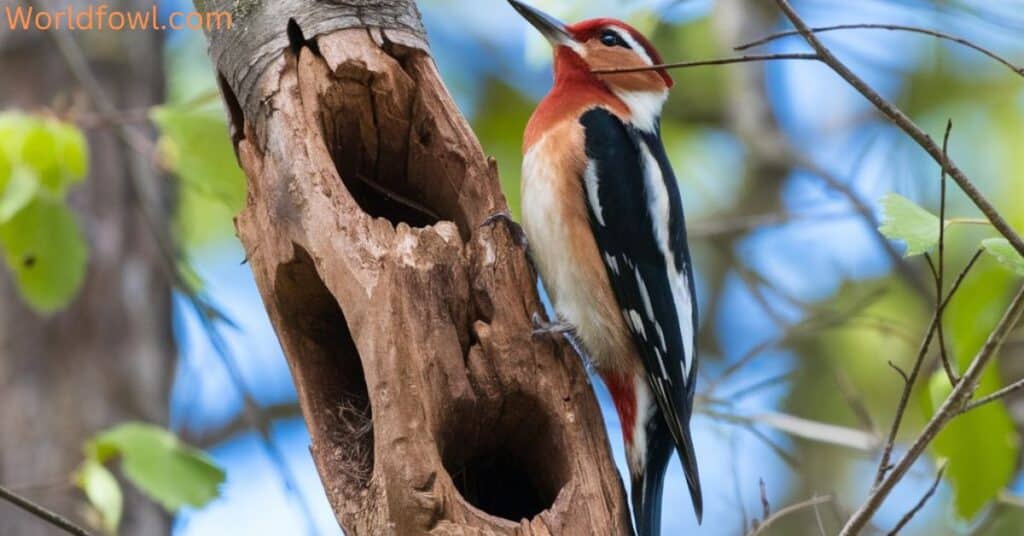
The Red-naped Sapsucker is primarily found in British Columbia’s interior, where it plays a crucial role in forest ecosystems.
Identifying features:
- Red throat and nape
- Black and white striped face
- Yellow belly
Hybrid zones with Red-breasted Sapsucker:
- Hybridization occurs where ranges overlap in central British Columbia
- Hybrids show intermediate characteristics
Seasonal movements in British Columbia:
- Breeds in interior forests
- Some individuals move to lower elevations or coastal areas in winter
Williamson’s Sapsucker
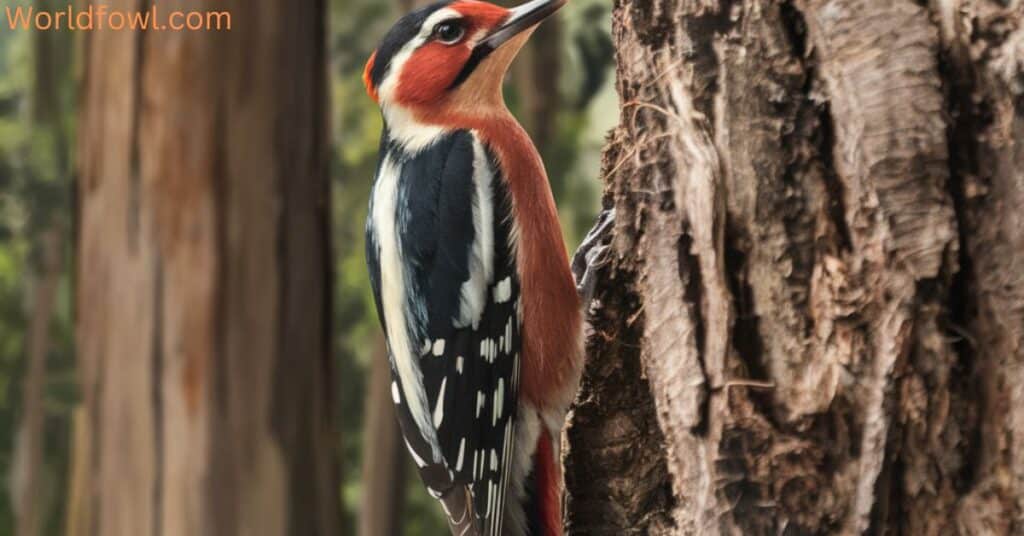
The Williamson’s Sapsucker is one of British Columbia’s most striking and elusive woodpeckers, known for its extreme sexual dimorphism.
Extreme sexual dimorphism:
- Males: Black body with yellow belly and red throat
- Females: Brown body with black and white barring
Limited range in British Columbia:
- Found only in the southern interior of the province
- Prefers mature coniferous forests, especially those with Western Larch
Conservation challenges:
- Blue-listed (vulnerable) in British Columbia
- Threatened by loss of mature forest habitat
you can read : Crane Vs. Heron – The Complete Comparison
Yellow-bellied Sapsucker
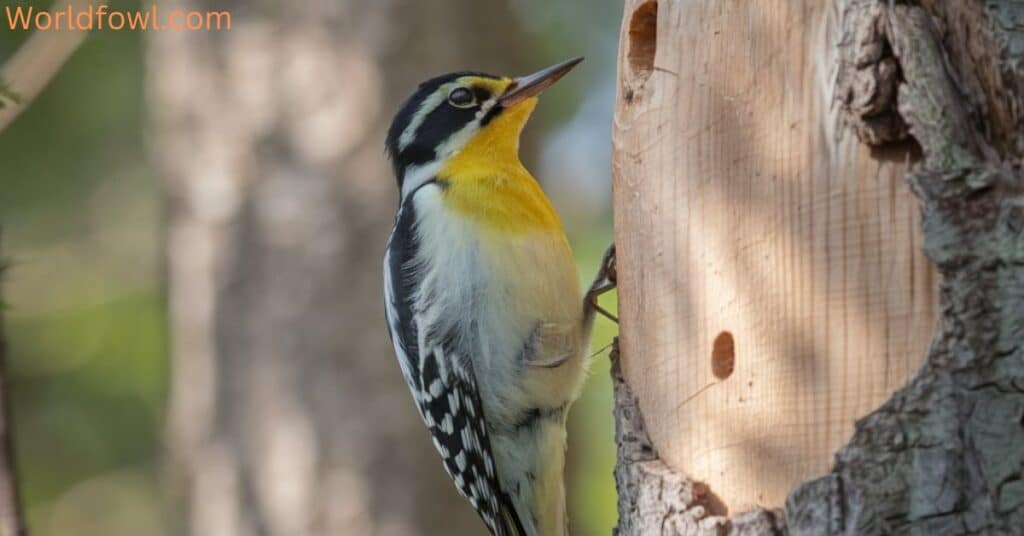
While less common in British Columbia than its red-breasted and red-naped cousins, the Yellow-bellied Sapsucker is an important part of the province’s woodpecker diversity.
Migratory patterns in British Columbia:
- Breeds in northeastern British Columbia
- Migrates south for the winter, with some individuals wintering on the coast
Tree preferences for sap wells:
- Favors paper birch and trembling aspen in British Columbia forests
- Creates distinctive horizontal rows of holes
Vocalizations and drumming patterns:
- Mewing call, similar to a cat’s meow
- Drumming is slower and more irregular than other woodpeckers
Woodpecker Ecology in British Columbia
Woodpeckers in British Columbia play a crucial role in the province’s forest ecosystems, influencing everything from insect populations to the availability of nesting sites for other species.
Role in forest health and pest control
Woodpeckers are nature’s pest control experts in British Columbia forests. They consume vast quantities of insects, many of which are considered forest pests. For example:
- A single Pileated Woodpecker can eat up to 11,000 carpenter ants in a day in British Columbia forests.
- Downy Woodpeckers are adept at finding and consuming bark beetle larvae, helping to control these destructive pests in British Columbia’s coniferous forests.
Cavity creation and its importance for other species
Primary cavity nesters, meaning they excavate their own nest holes. These cavities don’t just benefit woodpeckers; they’re crucial for many other species:
| Species | Uses woodpecker cavities for |
| Tree Swallows | Nesting |
| Northern Saw-whet Owls | Nesting and roosting |
| Red Squirrels | Denning |
| Bats | Roosting |
In British Columbia, over 50 species of birds and mammals use woodpecker-created cavities for nesting, roosting, or denning.
Adaptations to British Columbia’s diverse habitats
Woodpeckers in British Columbia have adapted to a wide range of habitats, from coastal rainforests to interior grasslands:
- Coastal adaptations: Red-breasted Sapsuckers have evolved to thrive in British Columbia’s wet coastal forests, preferring the sap of alders and maples.
- Interior dry forests: Lewis’s Woodpeckers have adapted to open ponderosa pine forests in British Columbia’s interior, developing a unique flycatching feeding strategy.
- High elevation specialists: American Three-toed Woodpeckers are adapted to cold, high-elevation forests in British Columbia where they specialize in eating bark beetles.
Threats and Conservation of Woodpeckers in British Columbia
Despite their adaptability, woodpeckers in British Columbia face numerous challenges in our changing world.
Habitat loss and fragmentation in British Columbia
The primary threat to woodpeckers in British Columbia is the loss and fragmentation of their forest habitats:
- Old-growth logging removes crucial nesting and foraging habitat for species like the Pileated Woodpecker in British Columbia’s coastal forests.
- Urban expansion reduces available habitat, particularly affecting species like the Northern Flicker in British Columbia’s populated areas.
- Agricultural development in the interior has significantly reduced habitat for Lewis’s Woodpecker in British Columbia’s Okanagan Valley.
Climate change impacts on woodpecker populations in British Columbia
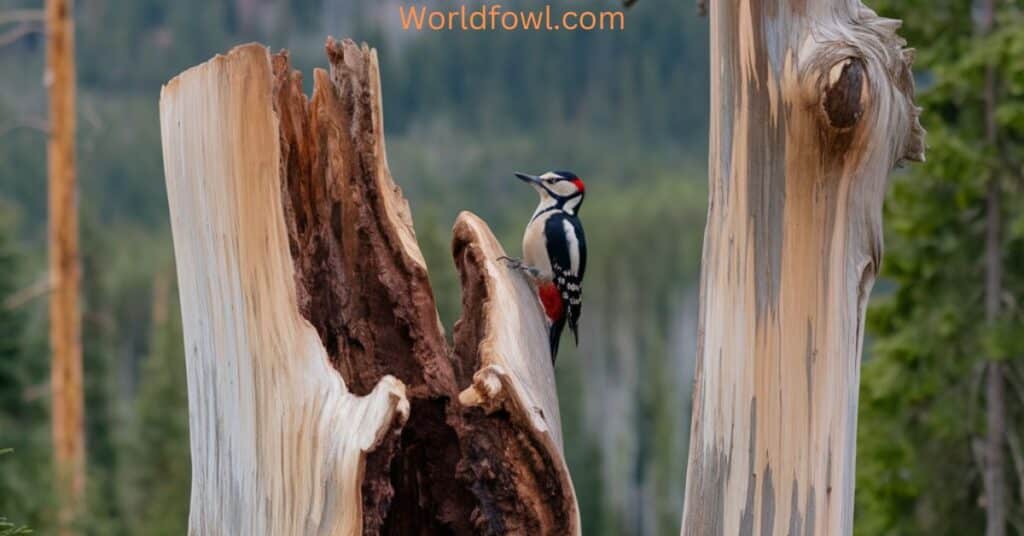
Climate change is altering British Columbia’s forests in ways that affect woodpeckers:
- Increased frequency and severity of wildfires may benefit some species (like Black-backed Woodpeckers) in the short term but could lead to long-term habitat loss.
- Changes in insect populations due to warmer temperatures could affect food availability for woodpeckers throughout British Columbia.
- Shifts in tree species composition may alter habitat suitability for specialized woodpeckers in various regions of British Columbia.
Success stories and ongoing conservation efforts for woodpeckers in British Columbia
Despite these challenges, there are positive conservation stories for woodpeckers in British Columbia:
- The Garry Oak Ecosystems Recovery Team has been working to restore habitat for Lewis’s Woodpeckers in the Okanagan region of British Columbia.
- The British Columbia government has implemented old-growth management areas, which benefit species like the Pileated Woodpecker throughout the province.
- Citizen science projects like the Christmas Bird Count provide valuable data on woodpecker populations and trends across British Columbia.
you may also like : 24 Yellow Birds In Ohio With Photos
Birdwatching Tips: Finding Woodpeckers in British Columbia
Woodpeckers can be some of the most rewarding birds to observe in British Columbia. Here are some tips to help you spot them:
Best locations for woodpecker watching in British Columbia
- Pacific Spirit Regional Park, Vancouver: Great for Downy, Hairy, and Pileated Woodpeckers
- Manning Provincial Park: Excellent for American Three-toed and Black-backed Woodpeckers
- Okanagan Valley: Prime habitat for Lewis’s Woodpecker and Williamson’s Sapsucker
- Carmanah Walbran Provincial Park: Perfect for Red-breasted Sapsuckers
Seasonal guide to woodpecker activity in British Columbia
- Spring: Best time to observe courtship behaviors and hear drumming .
- Summer: Good for observing nesting activities of woodpeckers throughout the province
- Fall: Watch for migratory movements of species like Yellow-bellied Sapsuckers in British Columbia
- Winter: Easier to spot woodpeckers due to leafless trees and their tendency to join mixed-species flocks in British Columbia forests
Equipment and techniques for spotting woodpeckers in British Columbia
- Binoculars: A good pair of 8×42 binoculars is ideal for woodpecker watching in British Columbia
- Field guide: “Birds of British Columbia and the Pacific Northwest” by Russell Cannings and Richard Cannings is an excellent resource
- Patience: Woodpeckers can be quiet and still when foraging. Take time to scan tree trunks carefully in British Columbia forests
- Listen: Learn to recognize woodpecker calls and drumming patterns common in British Columbia
Attracting Woodpeckers to Your British Columbia Backyard
Creating a woodpecker-friendly backyard in British Columbia can provide endless hours of enjoyment and contribute to conservation efforts.
Native plants that woodpeckers love in British Columbia
- Arbutus (Arbutus menziesii): Attracts insects that woodpeckers love in coastal British Columbia
- Pacific Dogwood (Cornus nuttallii): Provides berries and attracts insects for woodpeckers in British Columbia forests
- Bitter Cherry (Prunus emarginata): Offers both fruit and good foraging bark for woodpeckers throughout British Columbia
Feeder types and food preferences for woodpeckers in British Columbia
- Suet feeders: Excellent for attracting Downy, Hairy, and Pileated Woodpeckers in British Columbia backyards
- Peanut feeders: Popular with Northern Flickers throughout British Columbia
- Fruit feeders: Can attract sapsuckers in winter in various parts of British Columbia
Creating a woodpecker-friendly habitat in British Columbia
- Leave dead trees standing if safe to do so, providing natural habitat for woodpeckers in British Columbia
- Install nest boxes designed for woodpeckers common to your area of British Columbia
- Avoid using pesticides to ensure a healthy insect population for woodpeckers in your British Columbia garden
Woodpecker FAQs for British Columbia Residents
Dealing with woodpecker damage on homes in British Columbia
While woodpeckers rarely cause structural damage, their drumming can be annoying for British Columbia homeowners. Try these solutions:
- Install visual deterrents like reflective tape or owl decoys
- Cover affected areas with metal sheeting
- Provide alternative drumming sites, like specially designed woodpecker drums
Understanding woodpecker calls and drumming in British Columbia
Here’s a quick guide:
| Species | Call | Drumming Pattern |
| Pileated Woodpecker | Loud, laughing “cuk-cuk-cuk” | Slow, resonant drumming |
| Northern Flicker | Clear, loud “wick-wick-wick” | Rapid drumming with pauses |
| Downy Woodpecker | Sharp “pik” note | Fast, even drumming |
Myths and facts about woodpeckers in British Columbia
Myth: Woodpeckers harm healthy trees in British Columbia forests.
Fact: Woodpeckers primarily target dead or dying trees, or those already infested with insects.
Myth: Woodpeckers drill holes to get sap in British Columbia trees.
Fact: Only sapsuckers drill sap wells. Other woodpeckers are after insects or creating nest cavities.
Myth: All woodpeckers in British Columbia migrate south for the winter.
Fact: Many British Columbia woodpeckers are year-round residents, with only a few species migrating.
Citizen Science: Get Involved in Woodpecker Conservation in British Columbia
Citizen science projects are a great way for bird enthusiasts to contribute to woodpecker conservation and research in British Columbia.
British Columbia-specific bird count programs
- BC Breeding Bird Atlas: A comprehensive survey of British Columbia’s breeding birds, including woodpeckers
- Christmas Bird Count: Annual winter bird count that provides valuable data on woodpecker populations across British Columbia
- Project FeederWatch: A winter-long survey of birds that visit backyards, feeders, and parks in British Columbia
Reporting rare woodpecker sightings in British Columbia
- Use eBird to report your woodpecker sightings in British Columbia, especially of rare species like Lewis’s Woodpecker or Williamson’s Sapsucker
- Report any banded woodpeckers to the Bird Banding Office in Canada
Participating in habitat restoration projects for woodpeckers in British Columbia
- Join local conservation groups like the BC Wildlife Federation or Nature Vancouver
- Participate in invasive plant removal or native plant restoration projects that benefit woodpeckers in British Columbia
- Volunteer for nest box monitoring programs for woodpeckers throughout British Columbia
Conclusion: The Future of Woodpeckers in British Columbia
The future of woodpeckers in British Columbia is intrinsically linked to the health of our forests. As we face challenges like climate change and habitat loss, the role of these feathered ecosystem engineers becomes ever more crucial in British Columbia’s diverse ecosystems.
Importance of continued research and monitoring of woodpeckers in British Columbia
Ongoing research is vital to understand how woodpeckers are adapting to changing environments in British Columbia. This includes:
- Long-term population studies of woodpecker species across British Columbia
- Research on the impacts of forest management practices on woodpeckers in various regions of British Columbia
- Investigations into the effects of climate change on woodpecker habitats and food sources throughout the province
How individuals can make a difference for woodpeckers in British Columbia
Every British Columbia resident can play a part in woodpecker conservation:
- Create woodpecker-friendly spaces in your yard, no matter where you live in British Columbia
- Support sustainable forestry practices that benefit woodpeckers throughout British Columbia
- Educate others about the importance of woodpeckers in British Columbia’s ecosystems
By working together, we can ensure that the drumming of woodpeckers continues to echo through British Columbia’s forests for generations to come. The diversity and abundance of woodpeckers in British Columbia serve as a barometer for the overall health of our forests and ecosystems. As we continue to study, protect, and appreciate these remarkable birds, we not only secure their future but also preserve the rich biodiversity that makes British Columbia’s natural landscapes so extraordinary.

Henry James is a seasoned blogger and a passionate storyteller on “World Fowl.” With years of experience crafting engaging content, he brings a unique blend of expertise and creativity to his writing. Henry specializes in exploring diverse topics with depth and clarity, captivating readers worldwide.

